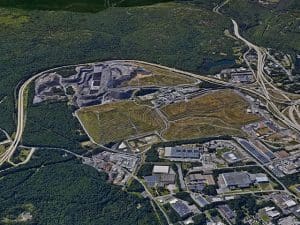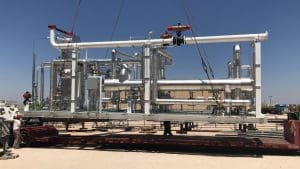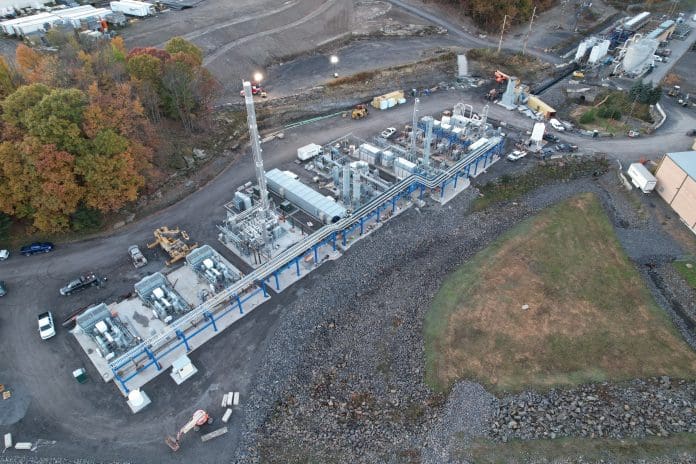Archaea Energy (Archaea) announced pipeline-quality renewable natural gas (RNG) production and commercial operations on December 30, 2021, at its Project Assai (Assai). According to Archaea, Assai is now the highest capacity operational RNG facility in the world.
Located at the Keystone Sanitary Landfill in Dunmore, Pennsylvania, Assai has natural gas production of 12,000 MMBtu/d, an inlet capacity of 22,500 SCFM (637 m3/min), is expected to reduce carbon dioxide (CO2) emissions by more than 220,000 tons (200,000 tonnes) per year, and reduce most air pollutants by more than 90%. If all goes according to plan, Assai will deliver more than 4 million MMBtu of RNG in 2022. Archaea estimates that the project will generate US$40 million in 2022 earnings before interest, taxes, depreciation, and amortization (EBITDA). For context, consider that Archaea’s full year 2021 guidance suggests EBITDA between US$72.5 million to US$77.5 million.

Assai combines landfill gas flows from the Keystone Sanitary Landfill and the Waste Management Alliance Landfill. At 714 acres (289 ha), the Keystone Landfill is one of the largest landfills in the United States. In June 2021, the Department of Environmental Protection (DEP) approved a long-awaited expansion to the Keystone landfill. The permit will allow Keystone to expand on a 435-acre (176-ha) space within its existing permitted area and increase its disposal capacity by 3915 scf (111 m3), a permit that Keystone waited roughly seven years for.
Archaea expects Assai to benefit from long-term landfill gas right agreements since the project is forecasted to yield decades of production and is within a large waste market. In fact, 80% of Assai’s total RNG volume is already contracted on a long-term fixed fee basis with FortisBC Energy Inc., Énergir, L.P., and The Regents of the University of California, for periods of up to 20 years.
“Completion of Assai is a monumental moment for Archaea,” said Nick Stork, CEO of Archaea. “I would first like to thank our team. I also want to thank the Keystone Sanitary Landfill, their incredible people and ownership. Keystone’s cooperation, vision, and world-class operations were critical to the success of the project. I am also thankful for our partnerships with Waste Management, UGI, and the Pennsylvania Department of Environmental Protection, as well as our commercial partners, FortisBC Energy Inc., Énergir, L.P., and The University of California System, who have all made meaningful long-term commitments to decarbonization and to the success of this project. Last but not least, I am grateful for the many learnings that came from this project. We self-performed many critical aspects of this project that most would have outsourced. The compounding effects of this knowledge will translate to lower costs and faster timelines for landfill owners and offtake partners across North America.”
Landfill Methane Emissions Are A Big Problem
According to the US Environmental Protection Agency (EPA), municipal solid waste (MSW) landfills contributed about 15% of human-related methane emissions in 2018, roughly equivalent to the greenhouse gas (GHG) emissions of 20.6 million passenger cars or 11 million US homes. Landfill emissions primarily come from landfill gas (LFG). A natural byproduct of the decomposition of organic material, LFG consists of about 50% methane and 50% CO2.
One option is to flare LFG, which costs money and is harmful to the environment. Another solution is to turn LFG into useful energy, also called RNG, by either increasing its methane content or removing non-metage components. Archaea’s Assai facility is the latter option. By removing non-methane components, it creates RNG that can be used as a drop-in replacement for pipeline gas, compressed natural gas (CNG), or even liquefied natural gas (LNG).
How Assai Fits Into Archaea’s Big Picture
Archaea plans to be the largest RNG producer in the United States this year. Archaea believes that RNG produced from landfill gas (as opposed to dairy manure, wastewater, or food waste) is a low cost and predictable renewable energy feedstock. Archaea has more than two dozen operating sites consisting of 10 LFG facilities, two RNG facilities, and 17 LFG-to-electric facilities, as well as 35 development projects. “Beyond Project Assai, we have additional greenfield development projects at various sizes in our development portfolio,” said Stork on the company’s Q3 2021 conference call. “Our development plan will require execution on a scale that has never been done in the RNG industry. We are confident in our ability to execute on our development plan and today, we see timing as the most meaningful driver of uncertainty in our model. Some elements remain outside of our control like permitting, zoning, and pipeline interconnection. However, we’re extremely confident that the long-term earnings power of our project backlog is locked in. We have been building out teams, processes, and the supply chain to solid execution and that’s our focus on removing the development risks to the extent that we can. We’re making significant investments in equipment and people to help facilitate rapid development over the next two to three years and beyond, and we have additional work to do in this area as we trend toward internalization of our supply chain.”
As mentioned, 80% of Assai’s projected volumes are already contracted under long-term contracts. Archaea plans to leverage this commercial strategy through its other projects as well. It is guiding for at least 70% of RNG volumes to be contracted under 10- to 20-year long term contracts once its greenfield projects come onstream. Archaea is an example of an energy company that values the predictability that long-term contracts provide, as well as their ability to insulate a company from volatile market pricing. Archaea has repeatedly stressed its focus on generating positive EBITDA to grow its business through a lens of stable returns that foster long-term shareholder value. In this sense, it is proving that RNG can be an environmentally beneficial and profitable business model that can also play a key role in the energy transition.
Archaea’s NW Natural Deal
The Assai announcement comes just weeks after Archaea landed its first deal with a US utility.
In November 2021, Archaea entered a long-term RNG purchase and sale agreement with NW Natural Holdings, which provides natural gas service to around 2.5 million Oregon and Southwest Washington residents.
“Under the agreement, NW Natural will purchase the environmental attributes generated by Archaea related to up to one million MMBtu of RNG annually from its portfolio of RNG production facilities for a fixed fee for a period of 21 years,” said Archaea in a statement. “The agreement will commence in early 2022, with the full annual quantity beginning in 2025. The RNG produced by Archaea for this long-term partnership is expected to have a positive impact through avoided methane emissions at US landfills and displacement of conventional natural gas.”
“We are pleased to partner with NW Natural and look forward to our multi-decade business relationship,” said Stork. “This agreement, our first with a US utility, is a testament to the strength of our commercial offerings and highlights our ability to help utilities provide lower carbon options to their customers and achieve their sustainability goals.”
“We’re excited to work with the experienced leadership at Archaea to help lower emissions on behalf of our customers,” said David H. Anderson, NW Natural president and CEO. “This agreement is another meaningful step on the path to achieving our long-term carbon neutrality goal, while also helping communities close the loop on waste.”
Other Partnerships
Archaea’s deal with NW Natural follows a series of partnerships

aimed at growing the production and use of RNG to reduce global emissions.
Earlier this year, BCCK Holding Company (BCCK), an engineering, procurement, fabrication, and field construction services company, announced that it will provide Archaea with a 13,700-SCFM (388-m3) Style IV NiTech Nitrogen Rejection Unit (NRU). In addition to the NRU, BCCK is providing Archaea with oxygen and CO2 removal systems and residue compression that will be integrated with the remainder of the gas plant being provided by Archaea. BCCK’s NRU and associated equipment are operating at the Assai facility.
Archaea’s Nationwide Aspirations
Founded in 2018 and based out of Pennsylvania, Archaea is aggressively developing seven projects throughout the United States that aim to reduce GHG emissions from existing natural gas infrastructure. Six of the seven projects aim to produce a combined 20,487 Mscf/d (5.8 × 105 m3/d) of RNG, over half of which will be from the Assai plant. The seventh project will utilize gas from two landfills in Newport Beach and Colton, California, to produce 7 tons (6.4 tonnes) per day of hydrogen. Archaea received funding from the Rice Investment Group and Saltonstall & Co. and has partnered with notable institutions, including the University of California (UC) system. Archaea’s Bernie project in San Bernardino Country will deliver clean methane to an onsite treatment plant that will turn it into RNG for use on UC campuses.

A Solution Warranting Consideration
Solar and wind energy farms and hydroelectric plants deservingly get a lot of recognition for their environmental impact, use of new technology, and status as engineering marvels. But there are plenty of criminally underrated short-term solutions. RNG is quite possibly one of the best examples of a fuel source that can readily lower emissions and spur economic growth.
By capturing and cleaning methane from municipal solid waste in landfills, wastewater, food waste, and dairy manure, a carbon negative fuel source can be created and used in existing pipelines. As a drop-in replacement for natural gas, RNG has the same use cases in power generation, industrial production, residential use, and the transportation industry as CNG and can even be cooled and condensed in the form of LNG and shipped to energy dependent countries overseas.
RNG isn’t sexy, and it probably never will be. But it’s a great story that deserves to be recognized so that it can receive higher investment, increased consideration in federal, state, and local policy, and more media attention.

















